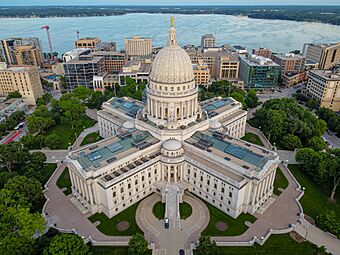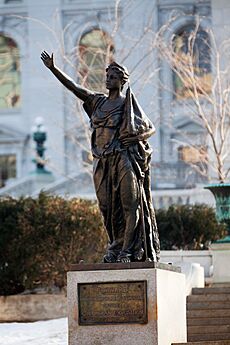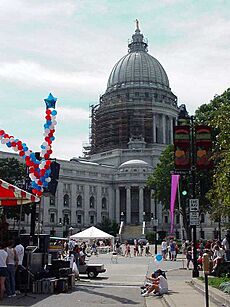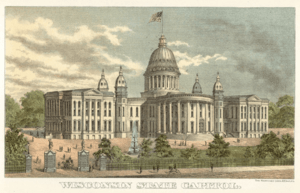Wisconsin State Capitol facts for kids
|
Wisconsin State Capitol
|
|
 |
|
| Location | 2 East Main Street, Madison, WI 53703 |
|---|---|
| Built | 1917 |
| Architect | George B. Post |
| Architectural style | Beaux-Arts |
| NRHP reference No. | 70000031 |
Quick facts for kids Significant dates |
|
| Added to NRHP | October 15, 1970 |
| Designated NHL | January 3, 2001 |
The Wisconsin State Capitol is a very important building in Madison, Wisconsin. It is where the laws for Wisconsin are made. This building is home to the Wisconsin Legislature, which is like the state's parliament. It also houses the Wisconsin Supreme Court, which is the highest court in the state. The Governor of Wisconsin also has an office here.
The Capitol was finished in 1917. It is the fifth building to be the capitol for Wisconsin. The first one was used in 1836 when Wisconsin was still a territory. This Capitol is the tallest building in Madison. A special law keeps other buildings from being taller than its dome. The Capitol is in downtown Madison, surrounded by streets that form Capitol Square.
Contents
History of the Capitol Buildings
Wisconsin has had several capitol buildings over the years. Each one served its purpose as the state grew.
The First Capitol
The very first capitol was a simple wooden building. It was quickly sent to Belmont. This building had no heat or running water. Lawmakers met there for only 42 days. They decided that Madison would be the permanent capital. The first capitol building still stands today. You can visit it as a historic site.
The Second and Third Capitols
The second capitol was built in 1837 in Madison. It was made of stone and local oak. This building was small but typical for a new frontier state. As the government grew, a new capitol was needed.
The third capitol was built on the same spot. It looked like the U.S. Capitol with a dome. Construction took place between 1857 and 1869. Later, in 1882, two new wings were added.
The Great Fire of 1904
On February 26, 1904, a fire started in the third capitol building. A gas jet lit a newly varnished ceiling. The building had a fire system, but the water supply was empty. The fire spread quickly. Firefighters from Madison and Milwaukee worked hard. Their equipment even froze because of the cold weather.
Most of the building burned down. Many important records and historical items were lost. Luckily, university students saved many law books. The state had just canceled its fire insurance policy.
Construction and Design of the Current Capitol

Building the current Capitol started in late 1906. It was finished in 1917. The cost was about $7.25 million. The architect was George B. Post & Sons from New York. He designed the Capitol to look the same from all sides. This way, no business on Capitol Square felt like it was on the "back" of the building.
The building was constructed one wing at a time. This helped with costs and provided office space sooner.
The Wisconsin Statue
The Capitol is 284 feet tall from the ground to the top of the dome. On top of the dome is the Wisconsin statue. It was sculpted in 1920 by Daniel Chester French. The statue is made of bronze and covered in gold leaf. It is 15 feet, 5 inches tall and weighs three tons.
The statue holds a globe with an eagle in its left hand. Its right arm is stretched out. This symbolizes Wisconsin's motto, "Forward." It wears a helmet with a badger on top. The badger is Wisconsin's state animal. People sometimes mistakenly call this statue Lady Forward.
Inside the Dome
If you look up from the center of the building, you will see a mural. It is called Resources of Wisconsin. Edwin Howland Blashfield painted it. The mural shows a woman on a throne of clouds. She represents Wisconsin. Other women around her are reaching for goods like tobacco and fruits.
Building Materials
The Capitol was built using 43 types of stone. These stones came from six countries and eight states. The outside of the building is made of white granite from Vermont. This makes the dome the largest granite dome in the world.
Inside, the floors, walls, and columns are made of marble. This marble came from many states like Tennessee and New York. It also came from countries like France and Italy. Other types of granite and limestone are also used.
The Capitol was named a National Historic Landmark in 2001. A state law from 1990 protects its height. No building within one mile can be taller than the Capitol's dome base.
Restoring the Capitol

From 1988 to 2002, the Capitol went through a big renovation. It cost about $158.8 million. The project worked on one wing at a time, just like when it was first built. The goal was to make the Capitol a modern workplace. They also wanted to bring back its original 1917 look.
In the 1960s and 70s, some changes were made that did not fit the building's style. Things like dropped ceilings and fluorescent lights were added. Many original decorations were painted over. The restoration project fixed these changes. Public areas were returned to their original appearance. Hidden stairs were uncovered. The outside granite was cleaned and repaired.
Modern technology was also added. Electrical, plumbing, and heating systems were updated. Air conditioning was installed. The basement floor was lowered to create more office space. Lawmakers now have two-room offices. New office furniture was designed to look like the original oak pieces.
Sculptures and Art
The architect, George B. Post, planned many sculptures for the building. These sculptures tell stories and represent ideas.
Dome Sculptures
The four small domes at the base of the main dome were replaced by sculptures. These groups were created by Karl Bitter. They represent important ideas like Faith, Strength, Prosperity and Abundance, and Knowledge. These figures are dressed in Greek-style clothing.
Pediment Sculptures
Each of the four wings has a special sculpture above its entrance. These are called pediments. The figures on them relate to what happens inside that wing.
- The east wing houses the Supreme Court. Its pediment by Karl Bitter is called Law.
- The south wing holds the State Senate. Its pediment by Adolph Alexander Weinman is Virtues and Traits of Character.
- The west wing's pediment by Karl Bitter is Agriculture.
- The north pediment is Wisdom and Learning of the World by Attilio Piccirilli.
The Piccirilli Brothers carved all these amazing sculptures.
Fossils in the Capitol
You can find real fossils hidden in the stone throughout the Capitol building! It's like a treasure hunt. Here are some places to look:
- Starfish: North wing, left grand stairs, 1st to 2nd floor, fourth step from bottom.
- Coral: West wing, second floor, railing overlooking central corridor, outside of Assembly chamber.
- Nautiloid: North wing, second floor, left of north hearing room entrance.
- Gastropod: West wing, left grand stairs; 1st to 2nd floor railing, above 9th step from top.
- Ammonoid: North wing, second floor, north hearing room.
- Bryozoan: South wing, second floor, left grand stairs, top step.
- Burrows: Northwest, second floor, wall to right room 225 NW.
- Brachiopods: East wing, ground floor, pillars near entrance.
Images for kids
-
North pediment by Attilio Piccirilli
-
South pediment, Virtues and Traits of Character by Adolph Weinman
-
East pediment by Karl Bitter
-
Wisconsin State Senate chambers
See also
 In Spanish: Capitolio del Estado de Wisconsin para niños
In Spanish: Capitolio del Estado de Wisconsin para niños
- List of state and territorial capitols in the United States
- 2011 Wisconsin protests
- National Register of Historic Places listings in Madison, Wisconsin
- List of National Historic Landmarks in Wisconsin














